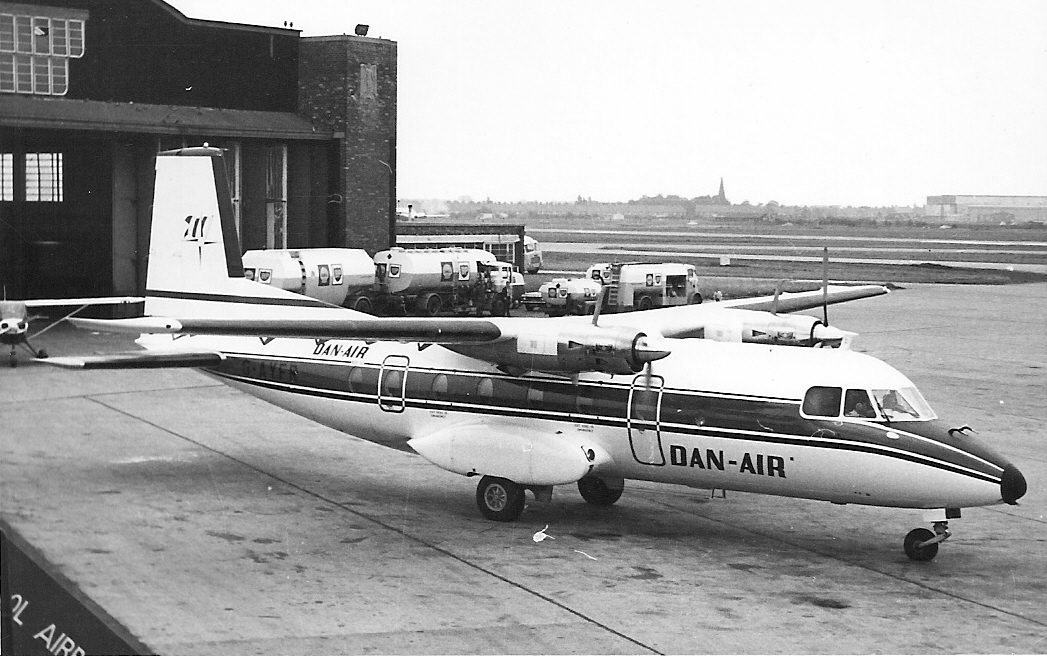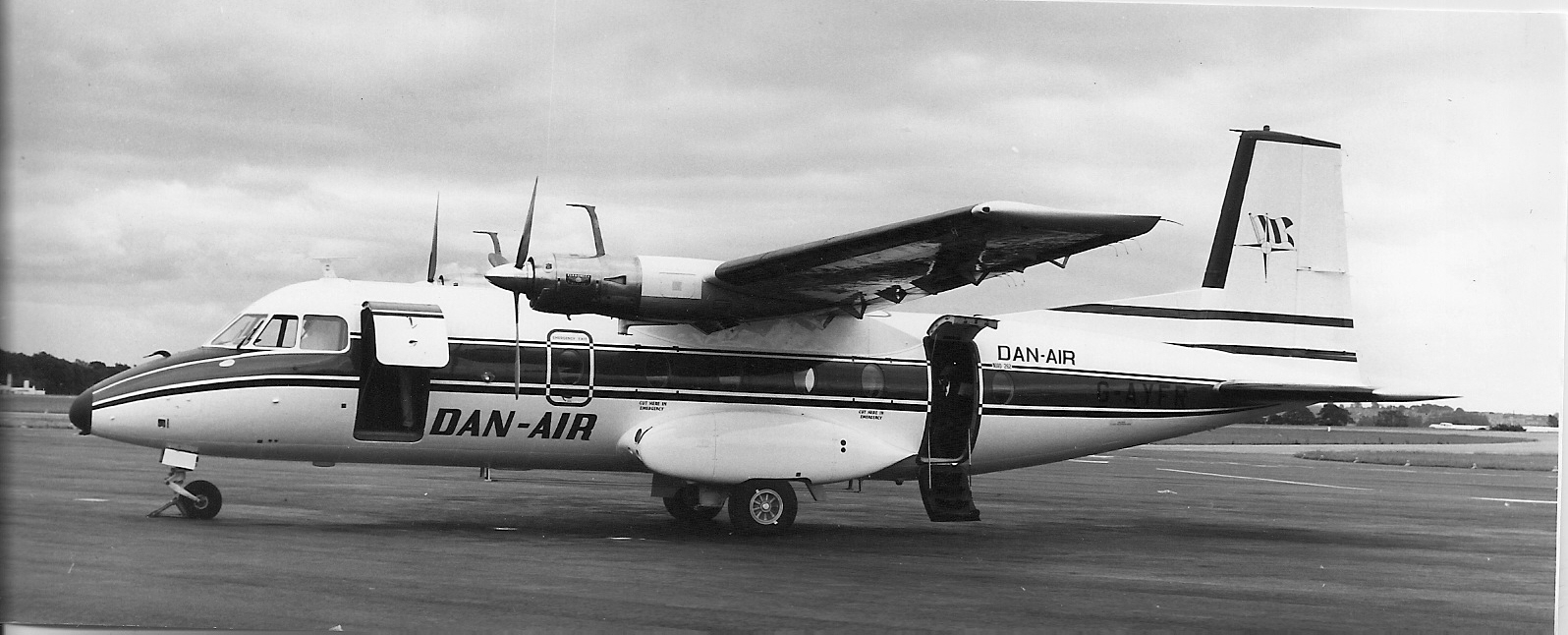DAN-AIR'S SEARCH FOR A DC-3 REPLACEMENT
INAUGURAL SERVICE
Several hours of crew training at Newcastle followed, while DC-3 G-AMPP continued to maintain the route in her very own inimitable fashion. A number of regular passengers on the route expressed their sorrow at the forthcoming retirement of this cherished member of the Dan-Air fleet, and one businessmen insisted on buying a ticket for her last flight, whenever it was going to take place. Although planned to take over on July 27, the Nord 262 went into full Dan-Air operation earlier than expected. On July 22 it was decided that sufficient crews had been checked out on the new airliner, and while G-AMPP flew her final service on the morning of July 22 flying from Bristol via Cardiff and Liverpool to Newcastle (arriving at 0930 GMT), the Nord 262 operated the southbound evening service. She departed from Newcastle at 1700GMT, and flew via Liverpool and Cardiff to Bristol, where she arrived shortly after 1930 GMT to conclude a highly successful service debut.
Subsequently the Nord 262 settled into a weekday routine of flying Newcastle-Liverpool-Cardiff-Bristol-Manchester-Newcastle-Manchester-Bristol-Cardiff-Liverpool-Newcastle on Tuesdays and Thursdays, while on Mondays, Wednesdays and Fridays the aircraft tracked the route by a rather different manner flying Newcastle-Manchester-Bristol-Cardiff-Liverpool-Newcastle-Liverpool-Cardiff-Bristol-Manchester-Newcastle. The higher 200 knot cruising speed, as opposed to the DC-3's 145 knots, and faster turn-around times allowed the Nord to operate many extra sectors in a day, with a higher utilisation and more attractive timings hopefully increasing custom on the network.
And so DC-3 G-AMPP was pensioned off and flown to Lasham, having amassed a total of over 18,000 flying hours, 12,000 of which had been amassed with Dan-Air. She never flew again, but for many years was placed on display outside the Dan-Air maintenance facilities at Lasham, where she masqueraded as 'G-AMSU', the airline's first DC-3.
NEW OPERATING TECHNIQUES
 Dan-Air Nord 262A G-AYFR with her starboard Bastan running on the apron at Liverpool Airport. (Merseyside Aviation Society)
Dan-Air Nord 262A G-AYFR with her starboard Bastan running on the apron at Liverpool Airport. (Merseyside Aviation Society)
The Nord 262 soon proved popular with passengers and crew alike, and the operation took on a more efficient air as the aircraft settled into daily service. Time on the ground was critical to the success of the service, with the Nord generally spending about ten minutes in between touchdown and take-off on the intermediate sectors. This was achieved by having the passengers ready at the departure gate and by the aircraft only shutting down the port Bastan, leaving the starboard running whilst passengers disembarked and others boarded. This meant that the flight crew remained busy on the flight deck, and as soon as the rear passenger door was closed, the aircraft would call for taxy clearance.
On one occasion at Cardiff in the autumn of 1971 this intensity created a problem after leaving the apron on another sector to Liverpool. G-AYFR had landed five minutes earlier on runway 31 inbound from Liverpool, and having vacated the runway alongside the local flying club, had parked on the main apron adjacent to the original terminal. Keeping her starboard engine running throughout, the passengers had exchanged their seats and with everyone safely aboard, the door was closed and the aircraft requested taxy clearance. This was duly issued, with instructions to cross the main runway, then proceed along the parallel taxiway to the holding point for runway 31. As the aircraft turned through 180 degrees leaving the apron, it became apparent that something was wrong. From the control tower, it seemed that a section of the port lower fuselage was missing, exposing the area around the main undercarriage wheel. This observation was passed to the crew, who insisted that the aircraft was fully serviceable and that they were now requesting airways clearance and permission to take-off. As the Nord 262 raced towards the holding point, anxiety in the control tower led to a member of the fire service being despatched in a Land Rover to inspect the side of the aircraft and report his findings. This he did by radio, confirming that there did appear to be a chunk of fuselage missing. Disbelief on the flight deck eventually gave way to common sense, and the aircraft returned to the main apron, where both engines were shut down, the passengers disembarked and a red-faced crew left to inspect the damage to the aircraft. Repairs were soon carried out, and the aircraft placed back in service. Later in the day, a farmer in the Brecon area telephoned the airport to report that he had found an item in one of his fields that he believed had fallen from an aircraft. It seems likely that during the earlier descent in to Cardiff, this piece of the aircraft had for some reason broken away. Although it made the aircraft appear unsightly, the lack of this part of the fuselage had not affected the structural integrity of the aircraft in any way.
Apart from the scheduled services linking Wales and the West Country with Liverpool, Manchester and Newcastle, the Nord also undertook other flying on the Dan-Air network and also occasional ad-hoc charter work. This included a Ronaldsway to Prestwick passenger schedule on August 15 1970, a Manchester to Aldergrove newspaper charter on the night of December 18 1970, followed on the very next day by a charter carrying Wardair passengers from Manchester to Prestwick. A similar charter was flown from Prestwick to Manchester on January 9 1971, and later in the year the Nord would become a regular participant on the Dan-Air summer schedule linking the Isle of Man with Prestwick. G-AYFR carried 26 passengers from Prestwick to Ronaldsway on April 18 1971, and thereafter visited every weekend until the end of the season.
May 1971 saw further variety for the Nord 262, with the aircraft flying charters from Liverpool to Gatwick and Luton on May 7 and 8, while on May 13 the aircraft undertook a route proving flight from Leeds to Glasgow and return in anticipation of the opening of this new route. Subsequently inaugurated by Dan-Air's newly acquired Avro 748 G-ARAY on June 1, the Nord appeared on the route on June 2 and 4, but otherwise remained dedicated to the "Link City" (as it was now called) schedule from Newcastle.
During the summer of 1971, when engineering or operational requirements dictated, the Nord would be replaced by Dan-Air's last Ambassador G-ALZO, and she flew the Newcastle to Cardiff and Bristol routes on several occasions during June and July. However, she had been retired by the time that a replacement was needed in November, and on one day, November 18, Dan-Air BAC One-Eleven 401 G-AXCK and Skyways International Avro 748 G-ARMX were both used to operate the "Link City" service.
The appearance of the Skyways 748 was no great surprise as Dan-Air were in the process of taking over this troubled airline, together with its fleet of 748 airliners. This take-over sounded the death knell for the Nord 262, as the 748 fleet would now take over Dan-Air's scheduled network. As a result the Nord flew her final service to Newcastle on January 26 1972. She was flown to Lasham on the next day, and then prepared for sale to Rousseau Aviation based at Dinard. Registered F-BTDQ she was delivered from Lasham, via Gatwick, to Dinard on February 22 1972, thereby concluding a successful eighteen month long period of colourful airline service with Dan-Air.
 Nord 262A G-AYFR in full Dan-Air livery on the Newcastle apron. (Ian MacFarlane)
Nord 262A G-AYFR in full Dan-Air livery on the Newcastle apron. (Ian MacFarlane)
'The Official
Website of
Propliner Aviation
Magazine'